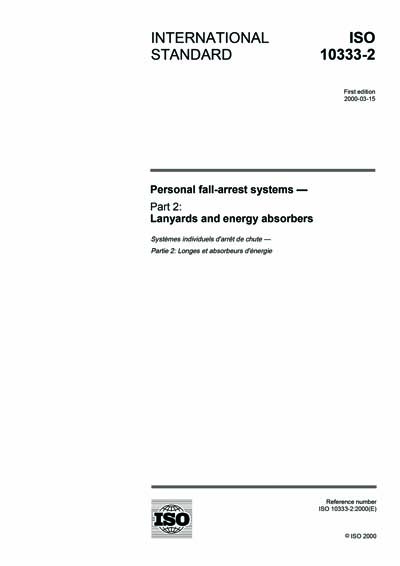Most recent
ISO 10333-2:2000
Personal fall-arrest systems - Part 2: Lanyards and energy absorbers
This part of ISO 10333 specifies requirements, test methods, instructions for use and maintenance, marking, labelling and packaging, as appropriate, for lanyards and energy absorbers.
Lanyards and energy absorbers are used together as a connecting subsystem in personal fall-arrest systems (PFAS) which will be specified in a future International Standard (see ISO 10333-6 in the Bibliography).
Two classes of energy absorbers are specified for the purposes of this part of ISO 10333:
- Type 1: used in PFAS where, due to installation, the potential free-fall distance can be limited to a maximum of 1,8 m and, if a fall takes place, the arresting force is limited to a maximum of 4,0 kN;
- Type 2: used in PFAS where, due to installation, the potential free-fall distance can be limited to a maximum of 4,0 m and, if a fall takes place, the arresting force is limited to a maximum of 6,0 kN.
This part of ISO 10333 is applicable only to lanyards and energy absorbers limited to single-person use of a total mass not exceeding 100 kg.
For the purposes of this part of ISO 10333, energy absorbers may be supplied integral to a lanyard, integral to a full body harness (FBH), or may be supplied separately.
The scope of this part of ISO 10333 does not extend to:
- PFAS that incorporate lanyards without energy absorbers or without a means of energy dissipation;
- special lanyards and energy absorbers which are integral (i.e. can only be separated by mutilation or by special tool) to the PFAS components as specified in ISO 10333-4.
This part of ISO 10333 does not specify those additional requirements that would apply when lanyards and energy absorbers are subjected to special conditions of use (where, for example, there exist unusual limitations concerning access to the place of work and/or particular environmental factors). Thus treatments to ensure the durability of the materials of construction (such as heat treatment, anti-corrosion treatment, protection against physical and chemical hazards) are not specified in this part of ISO 10333, but should comply with appropriate International Standards or, failing that, with national standards and other specifications dealing with relevant physical characteristics and/or the safety of users. In particular, when it is considered necessary to test the corrosion resistance of metallic parts of the equipment, reference should be made to ISO 9227.
Content Provider
International Organization for Standardization [iso]






